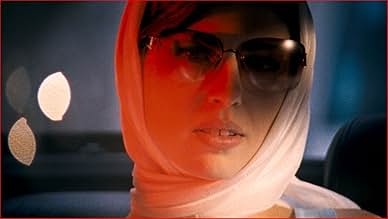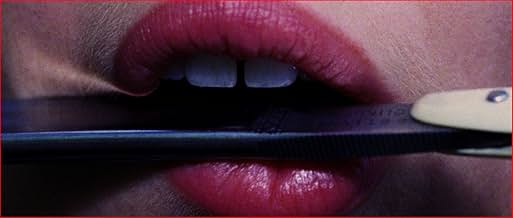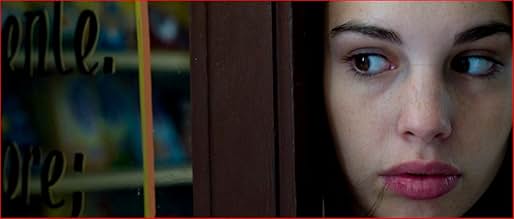AVALIAÇÃO DA IMDb
6,1/10
6,8 mil
SUA AVALIAÇÃO
Quando ela era uma criança, Anne era uma criança rebelde. Ela também foi atormentada por imagens de morte e uma figura escura e sinistra vestida de preto. Agora adulta, ela é mais uma vez at... Ler tudoQuando ela era uma criança, Anne era uma criança rebelde. Ela também foi atormentada por imagens de morte e uma figura escura e sinistra vestida de preto. Agora adulta, ela é mais uma vez atormentada por formas escuras e de outro mundo.Quando ela era uma criança, Anne era uma criança rebelde. Ela também foi atormentada por imagens de morte e uma figura escura e sinistra vestida de preto. Agora adulta, ela é mais uma vez atormentada por formas escuras e de outro mundo.
- Direção
- Roteiristas
- Artistas
- Prêmios
- 7 vitórias e 6 indicações no total
Charlotte Eugène Guibeaud
- Ana adolescente
- (as Charlotte Eugène Guibbaud)
Biancamaria D'Amato
- La mère
- (as Bianca Maria D'Amato)
- Direção
- Roteiristas
- Elenco e equipe completos
- Produção, bilheteria e muito mais no IMDbPro
Avaliações em destaque
Amer is an example of pure cinema if ever there was one. It's a movie with extremely little plot and very minimal dialogue. While on one level it's a homage to the Italian giallo film, it's at least equally an avant-garde experimental piece. If you could imagine a collision between Suspiria, A Lizard In A Woman's Skin and Meshes of the Afternoon you wouldn't be too far off the mark. It's similarity to the latter Maya Deren film is where it might be problematic to those who think they are in for a true homage to the giallo, as this is a movie that is more of a mood piece than anything else. Admittedly it's a pretty dark mood but nevertheless this is first and foremost an experimental work. Your tolerance level for narrative-free avant-garde cinema will be the deciding factor in whether you like this or not.
It's about a girl called Ana. And it's divided into three sections: childhood, adolescence and adulthood. The first part is the most impressive; it's a deeply creepy segment about the child at a highly traumatic moment in her life, involving her dead grandfather and her witnessing her parents having sex. It's full of surreal nightmare imagery that recalls some shots directly lifted from Suspiria, with the requisite intense colours – greens, blues, reds – with a creepy soundtrack of sighs that also recalls that famous old film. The second part loses the momentum a bit; it switches to a sunny outdoor locale and has the teenage Ana accompany her mother in a trip to the local town, where she seems to experience some sexual awakenings. The final part has Ana arriving at the run down family home again; this part incorporates some of the fetishistic giallo motifs that you might expect.
Amer is a highly stylised film. The cinematography is constantly inventive and artistic. There is a preponderance of close ups; in particular eyes and skin. The compositions are beautiful and the use of widescreen is excellent. When you see a film like this it does make you shake your head sadly when a film such as The King's Speech is nominated for best cinematography at the Oscars ceremony. As fine a film as it is the cinematography in that film, and most winners of this category in the Academy Awards, is solid yet so safe and unremarkable. This little film from Europe wins hands down against any contender from this year's Oscars in that category. But films like Amer are never nominated for Academy Awards and never will be. Rant over.
The film features a purely retro music soundtrack from the likes of Bruno Nicolai, Ennio Morricone and Stelvio Cipriani; the opening piece being from the Sergio Martino giallo film The Case of the Scorpion's Tail. And I suppose that opening would make you think this film is going to be a straight homage but as I have said it really isn't. Amer is most certainly not a film for everyone it has to be admitted but if you like gialli and avant-garde cinema then I think you would do well to at least give it a try.
It's about a girl called Ana. And it's divided into three sections: childhood, adolescence and adulthood. The first part is the most impressive; it's a deeply creepy segment about the child at a highly traumatic moment in her life, involving her dead grandfather and her witnessing her parents having sex. It's full of surreal nightmare imagery that recalls some shots directly lifted from Suspiria, with the requisite intense colours – greens, blues, reds – with a creepy soundtrack of sighs that also recalls that famous old film. The second part loses the momentum a bit; it switches to a sunny outdoor locale and has the teenage Ana accompany her mother in a trip to the local town, where she seems to experience some sexual awakenings. The final part has Ana arriving at the run down family home again; this part incorporates some of the fetishistic giallo motifs that you might expect.
Amer is a highly stylised film. The cinematography is constantly inventive and artistic. There is a preponderance of close ups; in particular eyes and skin. The compositions are beautiful and the use of widescreen is excellent. When you see a film like this it does make you shake your head sadly when a film such as The King's Speech is nominated for best cinematography at the Oscars ceremony. As fine a film as it is the cinematography in that film, and most winners of this category in the Academy Awards, is solid yet so safe and unremarkable. This little film from Europe wins hands down against any contender from this year's Oscars in that category. But films like Amer are never nominated for Academy Awards and never will be. Rant over.
The film features a purely retro music soundtrack from the likes of Bruno Nicolai, Ennio Morricone and Stelvio Cipriani; the opening piece being from the Sergio Martino giallo film The Case of the Scorpion's Tail. And I suppose that opening would make you think this film is going to be a straight homage but as I have said it really isn't. Amer is most certainly not a film for everyone it has to be admitted but if you like gialli and avant-garde cinema then I think you would do well to at least give it a try.
The childhood segment that opens this, I felt, was a ten-star movie, a superbly strange horror seen in bewildering fragments through the eyes of a child. What especially makes it is the dreamlike giallo humour, particularly on show in Argento's Inferno, of the character advancing oblivious no matter how nightmarish and Freudianly creepy things become, and no matter how clumsily they themselves behave.
At the end of this part, sadly, as if not quite knowing what to do with the brilliant potential it's found, the film dissolves into abstraction, followed by two rather more mundane sequences from adolescence and adulthood.
There's still a lot to enjoy here. I really like it, especially that, at a time when so much art-house film feels leadenly stuck in numb, muted-colour naturalism, this is utterly wild in its deployment of current film and editing tech. If you're doubting whether movies can really astonish visually after the demise of celluloid, take heart. There are whole new worlds to discover here and Amer, while also owing much to the past, points the way.
Too bad then it applies this sensibility to more and more boringly disorienting strings of extreme close-ups, especially of eyes, and, mixed in the the bravura imagery, some that is really cheap and tacky looking, like student video in which they've tried to dress things up by bleaching it out too much and adding a sepia tint.
It feels like desperate and probably fairly conscious padding, because, unfortunately, there isn't anywhere near enough substance in the later sections to carry the day. Given that the first segment so perfectly captures the strangeness of a child's perception, a huge opportunity seems to me to have been missed to do the same for adolescence and adulthood. The closest we get is an acknowledgement that teenagers are very interested in sex, and, well, duh.
At the end of this part, sadly, as if not quite knowing what to do with the brilliant potential it's found, the film dissolves into abstraction, followed by two rather more mundane sequences from adolescence and adulthood.
There's still a lot to enjoy here. I really like it, especially that, at a time when so much art-house film feels leadenly stuck in numb, muted-colour naturalism, this is utterly wild in its deployment of current film and editing tech. If you're doubting whether movies can really astonish visually after the demise of celluloid, take heart. There are whole new worlds to discover here and Amer, while also owing much to the past, points the way.
Too bad then it applies this sensibility to more and more boringly disorienting strings of extreme close-ups, especially of eyes, and, mixed in the the bravura imagery, some that is really cheap and tacky looking, like student video in which they've tried to dress things up by bleaching it out too much and adding a sepia tint.
It feels like desperate and probably fairly conscious padding, because, unfortunately, there isn't anywhere near enough substance in the later sections to carry the day. Given that the first segment so perfectly captures the strangeness of a child's perception, a huge opportunity seems to me to have been missed to do the same for adolescence and adulthood. The closest we get is an acknowledgement that teenagers are very interested in sex, and, well, duh.
The NY TIMES called AMER "an exercise in giallo (eroticized horror), a richly colorful mosaic of sinister sidelong glances" while the LA TIMES enthused, "a nightmare vision of desire and fear -gorgeous, heady, dazzling!" but these pointed paeans are only partly true. Except for the odd snippet, there's no dialog or musical score in the three vignettes depicting the life of a disturbed young woman (childhood, adolescence, adulthood) and although the last sequence contains elements of the giallo, the film is more of an homage to the indelible images of "maestro of the macabre" Mario Bava.
AMER's first segment on a child's reaction to her grandfather's death re-imagines the opening tale in Bava's trilogy I TRE VOLTE DELLA PAURA (aka BLACK SABBATH) from prying a valuable object out of a dead man's hand and the nightmare that follows right down to the dripping water and eerie blue, green, and red light that bathed the terrifying tableaux. The second segment on the girl's dangerous sexual awakening combines Bava's OPERAZIONE PAURA (aka KILL BABY KILL) and it's white soccer ball with the nebulous evil-under-the-sun aura of Tennesse Williams' SUDDENLY LAST SUMMER. The third and final scene that sees the young woman revisiting the abandoned villa where she grew up actually does reference BLOOD & BLACK LACE-style gialli with its black gloves, straight razor, and stalking sequence that leads up to a graphic murder. Unfortunately, there's only one (barely set piece) slaying in AMER and this dreamy collage of jump cuts, split screens, and undeniably beautiful imagery is less than the sum of its parts which may prove disappointing to hard-core horror fans. Cineastes -and those who enjoy avant-garde narrative as well as color-drenched kaleidoscopic visuals- should, however, get their money's worth. Hélène Cattet & Bruno Forzani's offbeat endeavor also reeks of Roman Polanski's REPULSION and I found the "eroticized" exercise admirable but more dull than anything else.
AMER's first segment on a child's reaction to her grandfather's death re-imagines the opening tale in Bava's trilogy I TRE VOLTE DELLA PAURA (aka BLACK SABBATH) from prying a valuable object out of a dead man's hand and the nightmare that follows right down to the dripping water and eerie blue, green, and red light that bathed the terrifying tableaux. The second segment on the girl's dangerous sexual awakening combines Bava's OPERAZIONE PAURA (aka KILL BABY KILL) and it's white soccer ball with the nebulous evil-under-the-sun aura of Tennesse Williams' SUDDENLY LAST SUMMER. The third and final scene that sees the young woman revisiting the abandoned villa where she grew up actually does reference BLOOD & BLACK LACE-style gialli with its black gloves, straight razor, and stalking sequence that leads up to a graphic murder. Unfortunately, there's only one (barely set piece) slaying in AMER and this dreamy collage of jump cuts, split screens, and undeniably beautiful imagery is less than the sum of its parts which may prove disappointing to hard-core horror fans. Cineastes -and those who enjoy avant-garde narrative as well as color-drenched kaleidoscopic visuals- should, however, get their money's worth. Hélène Cattet & Bruno Forzani's offbeat endeavor also reeks of Roman Polanski's REPULSION and I found the "eroticized" exercise admirable but more dull than anything else.
Act 1 is brilliant - a terrifying, sensual, nightmarish homage to Dario Argento. Act 2 is boring filler. Act 3 has a nasty torture scene and is better than the second act, but still feels pointless.
Cattet and Forani are a Belgian couple who have made five short films together. This is their first feature. Divided into three parts, it focuses on childhood, adolescence, and womanhood in the life of Ana. Each moment is seen symbolically, very sensually, but without much discernible narrative, in a marvelous display of stylized visuals (in intensely colored and multiple-filtered 35 mm. images). There is a powerful, hit-you-over-the-head soundtrack. The material is fragmented, beginning with the images of eyes, presented in long horizontal rectangles. A girl is browbeaten by parents, or a couple anyway, whom she witnesses through a keyhole, shut in, and comes upon having sex. Later she also contemplates the hardening corpse of her dead grandfather. White grains under a bed. An ant. A spider. Loud booming sounds, which unfortunately in the Museum of Modern Art screening room blended with the underground sound of a rumbling subway line.
Later, the girl grows up and the film, which begins with dark interiors in an old house, switches to a sunny, Mediterranean, outdoor world. We are near Menton (credits indicate later), on the margin between the French and Italian Rivieras, along the Cote d'Azûr or the Amalfi Drive. A gang of motorcyclists with leather and metal and tight jeans stand by the road with their cycles. But we see only bits and pieces of them.
And this goes on and on, never ceasing to be beautiful, lushly noisy, sensual, fragmented, narrative-free. Amer, which means "bitter" in French, may be ideal for those who like to revel in "pure cinema."
There is one trouble though, and that this film tends to turn neurosis -- or desire, whatever it's about, which isn't altogether clear to me -- into a fashion shoot. It's said to mimic the style of Italian "giallo," pulp fiction, or the Daria Argento kind of stuff, and Italian movie music is among the many sonic allusions. Initially the feel is very much like something Spanish, or the Guillermo del Toro of Pan's Labyrinth. But as time goes on the impression of a fashion shoot undercuts the evocation of dream and fantasy through visual means. What might have been edgy, subtle, and memorable turns to chic kitsch. Or slick horror, when someone plays around with a straight razor in a threatening and suggestive manner as in Dali-Buñuel's Andalusion Dog.
While I and others with me found Amer hard going, despite its accomplished visuals, a British online reviewer called Alan Jones (reporting on the London Film4 Frightfest) was entranced, delighted with the evocation of Italian "gialli." He concludes, speaking of the late segment he explains is a walk along the highway to the hairdresser: "Charlotte Eugene-Guibbaud couldn't be more tantalizing as the hair-chewing Lolita either with her mini-dress hem flapping against her knickers at crotch-level. Maria Bos is pure Florinda Bolkan in the eyes-reflected-in-knife-blade finale, the portion where debts to A LIZARD IN A WOMAN'S SKIN are felt the most. Shimmering with a lush vibrancy and utilizing recycled Ennio Morricone, Bruno Nicolai, Stelvio Cipriani and Adriano Celentano music within its superb sound design, AMER carries an erotic and exotic charge I never thought could be replicated again outside such essential gialli as STRIP NUDE FOR YOUR KILLER or the classic Dario Argento Animal Trilogy. AMER is a faultless masterpiece, so just relax and breathe in the heady perfume of Cattet and Forzani's dazzling lady in black."
This glowing report shows the potential Amer has as a festival film that may, since Magnolia has bought it, get theatrical attention. However, in my view Cattet and Forani have not essentially moved up from their five short films to a feature, because this is merely short-film material spread out over ninety minutes, divided into three, and diced up into many edited visual fragments. A series of stylish pastiches does not a feature make. The conception is too slight and too fragmented to work as a real feature film. Nice eye candy though, and as Jones says, the sound design also is definitely "lush."
Shown as part of the New Directors/New Films series co-sponsored this year by MoMA and the Film Society of Lincoln Center and sown in New York at both the Walter Reade Theater and MoMA's Titus Theater in April 2010. Amer has been shown at many festivals between September 2009 and spring 2010.
Later, the girl grows up and the film, which begins with dark interiors in an old house, switches to a sunny, Mediterranean, outdoor world. We are near Menton (credits indicate later), on the margin between the French and Italian Rivieras, along the Cote d'Azûr or the Amalfi Drive. A gang of motorcyclists with leather and metal and tight jeans stand by the road with their cycles. But we see only bits and pieces of them.
And this goes on and on, never ceasing to be beautiful, lushly noisy, sensual, fragmented, narrative-free. Amer, which means "bitter" in French, may be ideal for those who like to revel in "pure cinema."
There is one trouble though, and that this film tends to turn neurosis -- or desire, whatever it's about, which isn't altogether clear to me -- into a fashion shoot. It's said to mimic the style of Italian "giallo," pulp fiction, or the Daria Argento kind of stuff, and Italian movie music is among the many sonic allusions. Initially the feel is very much like something Spanish, or the Guillermo del Toro of Pan's Labyrinth. But as time goes on the impression of a fashion shoot undercuts the evocation of dream and fantasy through visual means. What might have been edgy, subtle, and memorable turns to chic kitsch. Or slick horror, when someone plays around with a straight razor in a threatening and suggestive manner as in Dali-Buñuel's Andalusion Dog.
While I and others with me found Amer hard going, despite its accomplished visuals, a British online reviewer called Alan Jones (reporting on the London Film4 Frightfest) was entranced, delighted with the evocation of Italian "gialli." He concludes, speaking of the late segment he explains is a walk along the highway to the hairdresser: "Charlotte Eugene-Guibbaud couldn't be more tantalizing as the hair-chewing Lolita either with her mini-dress hem flapping against her knickers at crotch-level. Maria Bos is pure Florinda Bolkan in the eyes-reflected-in-knife-blade finale, the portion where debts to A LIZARD IN A WOMAN'S SKIN are felt the most. Shimmering with a lush vibrancy and utilizing recycled Ennio Morricone, Bruno Nicolai, Stelvio Cipriani and Adriano Celentano music within its superb sound design, AMER carries an erotic and exotic charge I never thought could be replicated again outside such essential gialli as STRIP NUDE FOR YOUR KILLER or the classic Dario Argento Animal Trilogy. AMER is a faultless masterpiece, so just relax and breathe in the heady perfume of Cattet and Forzani's dazzling lady in black."
This glowing report shows the potential Amer has as a festival film that may, since Magnolia has bought it, get theatrical attention. However, in my view Cattet and Forani have not essentially moved up from their five short films to a feature, because this is merely short-film material spread out over ninety minutes, divided into three, and diced up into many edited visual fragments. A series of stylish pastiches does not a feature make. The conception is too slight and too fragmented to work as a real feature film. Nice eye candy though, and as Jones says, the sound design also is definitely "lush."
Shown as part of the New Directors/New Films series co-sponsored this year by MoMA and the Film Society of Lincoln Center and sown in New York at both the Walter Reade Theater and MoMA's Titus Theater in April 2010. Amer has been shown at many festivals between September 2009 and spring 2010.
Você sabia?
- CuriosidadesShot on 16mm film and then blown up to 35mm to recreate the grainy effect of 1970s exploitation movies.
- ConexõesReferenced in Lost in Vienna, Austria (2013)
Principais escolhas
Faça login para avaliar e ver a lista de recomendações personalizadas
- How long is Amer?Fornecido pela Alexa
Detalhes
- Data de lançamento
- Países de origem
- Central de atendimento oficial
- Idioma
- Também conhecido como
- Amargo
- Locações de filme
- Empresas de produção
- Consulte mais créditos da empresa na IMDbPro
Bilheteria
- Orçamento
- € 880.000 (estimativa)
- Tempo de duração
- 1 h 30 min(90 min)
- Cor
- Mixagem de som
- Proporção
- 2.35 : 1
Contribua para esta página
Sugerir uma alteração ou adicionar conteúdo ausente

























